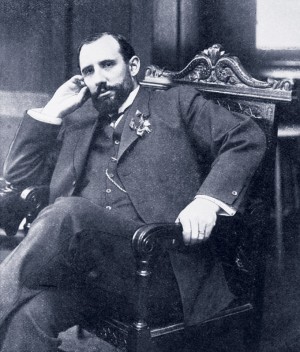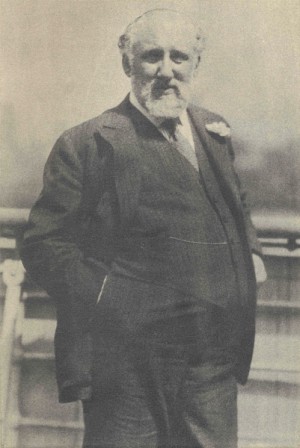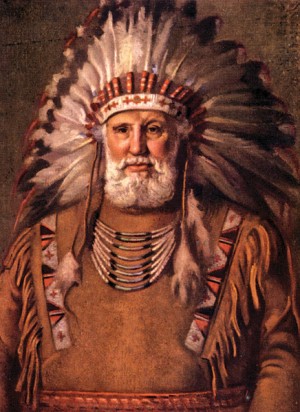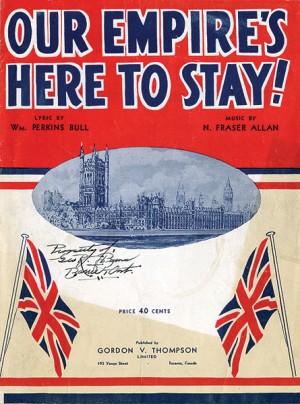William Perkins Bull
William Perkins Bull was so filled with energy, intelligence and initiative that he not only recorded history, he made it!
Nothing in Moderation: The Passion and Power of William Perkins Bull
A Chinguacousy farm boy who became a lawyer, businessman, developer, art patron, philanthropist and citizen of the world played a major role in preserving the history of Peel. But Perkins Bull was so filled with energy, intelligence and initiative that he not only recorded history, he made it!
Picture yourself in this situation. You are a cleaning maid. Times are tough and you’re happy to have a job. Your employer is wealthy, famous, powerful, connected; he speaks to prime ministers, presidents and kings. He is physically intimidating with a booming voice and is possessed of a life force that rattles windows.
One morning you put yourself in the path of that force as you dust a pair of priceless Sèvres vases and accidentally knock one off the mantelpiece. The echoing crash brings him charging in. You’ve never known such terror.
He hesitates, looks at you, and hesitates again. Then with a sweep of his arm he sends the second vase crashing to the floor.
“The one’s not much good without the other, you see,” he says, chuckling at his own wit, and then tells you to go back to work.
The story is true and it’s vintage Perkins Bull. The maid at the centre of it, one of several staff at Lorne Hall, Bull’s great house in Toronto’s Rosedale, told and retold it for years after.
By itself, a tale like this might stretch credibility, but it is supported by many similarly impressive tales. After all, for a man who had the first in-home elevator in Toronto, who kept a parrot that could imitate him to perfection, who turned downtown Brampton into a tizzy one day by spontaneously ordering up lunch for over one hundred people working on his history project, and whose friends once sneaked a live bull into his posh hotel room in New York, smashing a Sèvres vase for dramatic effect seems entirely in character.
Billiards with the King

Perkins Bull, 1911, youngest King’s Counsel in the British Empire, and founder of Red Deer Investments, an enterprise which eventually controlled some half-million acres in Alberta.
Perkins Bull was like the movie character Forrest Gump: either by coincidence or initiative, he was always in the middle of the action because of a seeming capacity to attract the rich and famous (whose ranks he joined very quickly).
In 1897, Bull was called to the bar and within nine years became the youngest K.C. (King’s Counsel) in the British Empire and was Timothy Eaton’s personal solicitor. Not long after graduation he sniffed opportunity in the sugar trade and along with William Van Horne, president of the CPR, travelled to Cuba and made his first purchase of plantation acreage. The investment grew to thousands of acres and made him both a fortune and a figure of influence in Cuba.
By 1904, Perkins Bull was a pal of Sir Sam Hughes and a member of his land development company in the Canadian west. The next step was to advise Sir Wilfrid Laurier’s government on native Indian policy. A few years more and Bull was a director of the Canadian Oil Company (White Rose), president of the Okanagan Lumber Company in B.C., and founder of Red Deer Investments, an enterprise which eventually controlled some half-million acres in Alberta.
It was the Red Deer operation that helped push him to the top of the social and business pyramid. In 1912, Perkins Bull moved his family to England, in part because it was an ideal spot to sell Alberta land, but also because, for a loyal and true blue worshipper of the Empire, it was home ground. Here, the combination of coincidence and initiative that seemed to rule his life took over again, for now he was right on site for World War I.
Ever the loyalist, Bull tried to enlist but, at 44, he was too old. Instead, he opened a convalescent hospital for wounded Canadian officers in his family’s home at Putney Heath in London and in an empty house across the street: the residence of Ernest Shackleton of South Pole fame. More than a thousand servicemen, including Billy Bishop and Georges Vanier, benefitted from this generosity.
Prime Minister Robert Borden was honorary president of the officers’ mess and no less a personage than Sir William Osler was the consulting physician. Together with Bull’s wealth and social status, the profile of the hospital raised the family to the permanent “A-list.” Writers such as Rudyard Kipling and movie stars such as Douglas Fairbanks Jr. were dinner companions, as was painter Solomon J. Solomon (whose portrait of Bull’s wife, Maria, was part of an internationally acclaimed exhibit at the CNE in 1921).
However, no recognition in the British Empire outshone that of a nod from royalty. Bull achieved this elevation when George V and Queen Mary dropped in. During the visit, Bull’s status was confirmed when the king suggested a game of billiards. There is no record of who won, but His Majesty is reported to have said that Bull “stroked a good cue.” Not bad for a farmer’s son from Chinguacousy Township.
From Chinguacousy to Rosedale via Wimbledon
William Perkins Bull was born in 1870 in Downsview, the second of eleven children born to Bartholomew and Sarah. When Bartholomew, a ramrod Wesleyan Methodist and arch teetotaller, turned to farming in Chinguacousy (in what is now the south end of the Town of Caledon), William as the oldest son automatically became a farmer too. Not a wealthy one either. In 1890, when he left for Victoria College at the University of Toronto, only his shoes were store-bought.
When Bartholomew died in 1904, Bull went back to the farm and, true to form, began a cattle breeding program that made the Bull’s Jersey operation among the largest in the world. But he soon left the farm to others in the family and not on the best of terms. The estrangement grew from the (unproven) suspicion that he must have been doing something illegal to make the farm so successful so quickly.
As it was, Perkins Bull had many other irons in the fire and by now was exceptionally well-supported by his intelligent, refined and accomplished wife, the former Maria Brennan from Hamilton. For a man destined to fly with eagles, she was the perfect partner. Their happy marriage produced seven children between 1899 and 1913, four boys, each of whom earned advanced degrees from Oxford, and three girls who “married well.” Maria’s adaptability and leadership played a vital role in the marriage as she and her husband travelled the world, living in a sequence of great homes in England (an estate at Wimbledon for one) before finally returning more or less permanently to Lorne Hall in Rosedale.
Although her name appeared regularly in the “What Women are Doing” column of The Globe and Mail, along with ladies from the Eaton family or the Pellatts (of Casa Loma fame) or various cabinet ministers’ wives, Maria was not just an attractive prop for the high profile William Perkins Bull.
The Brennan family had made a fortune in the lumber business and Maria’s upbringing in “proper” society helped her husband move confidently among the movers and shakers of the world, especially in the rigidly class-conscious circles that marked post-Victorian society.
Just as important as the grace Maria brought to their marriage was the fact that, like her husband, she too could make things happen. The convalescent hospital set up in World War I was as much her idea as his, and she became well known among the Canadian officer core for her thoughtfulness and genuine empathy, especially for the men whose minds needed healing even more than their bodies.
A Magnet for Controversy

Perkins Bull, historian. This imposing portrait was used as the frontispiece in several of his books. Photo Courtesy Region Of Peel Archives.
Regrettably, the prestige associated with the Bulls’ hospital did not remain unsullied. At first, and certainly as far as British Empire society was concerned, the venture was believed to have been financed entirely from Bull’s own pocket. It was an expensive undertaking, not just for the medical and infrastructure costs but also because both Perkins and Maria went to great lengths to make the place a pleasant one for the recovering officers, holding dinner parties for example, for up to forty people at a time.
After the war, however, and after the hospital closed in 1919, newspapers pounced on an investigative report that said Perkins Bull had received government per capitas for the patients and had also – gasp! – wheedled huge donations from wealthy Canadians (practices, of course, that have become standard fundraising tactics).
Still, whether or not he had outside support, Bull unquestionably put huge amounts of his own money into the undertaking. As for getting money out of rich friends, that seems to have been a normal feature of his skill set. Toronto politician, True Davidson, who worked for Perkins Bull during the Depression tells of how she stormed into a luncheon her boss was hosting and demanded $100 so his staff could eat, whereupon Bull shouted, “Turn out your pockets, gentlemen!” and took up a collection!
Those who knew him never disputed that Bull could be extremely parsimonious; after all he was once a poor farm boy. Yet True Davidson also makes clear in her autobiography that Bull paid her a proper wage, and acknowledges that although he was a challenge to work for, she “grew very fond of him.”
The media, however, did not always share the same fondness, and if the legacy of Perkins Bull is laced with controversy, it may be because Toronto newspapers delighted in seeking out his dark side. Although not a single accusation of shady dealings was ever officially proven, the press was always ready to pounce on the slightest hint of dirt.
His Red Deer Investments company was said to be selling northern tundra to unwitting English buyers, at the same time it was peddling English swamps to Canadian seniors. Although family lore has it that Maria talked him out of accepting a knighthood because it would be inappropriate for a Canadian, he was mocked in the Telegram for “failing in his desperate attempts” to garner a title.
In 1927, the press fell over itself when Bull was pointedly uninvited to a ceremony honouring his youngest brother, Jeffrey, killed in action in 1918. The Prince of Wales himself had come to Brampton to present a posthumous D.S.O. Even without the bad press the snub must have hurt Perkins Bull, not just for the missed opportunity to hobnob with royalty, but because Jeffrey was a favourite brother and his death had grieved Bull deeply.
Fortunately, the split in family relationships had pretty much healed well before Bull’s death – his bailing out one of his brothers during the Depression probably helped – but family aside, Bull faced even bigger controversies. One of these blew up in 1931 and was arguably the most serious he ever faced, and the most dangerous. However, to the people of Ontario, especially the people of Peel, the incident may also have been what triggered the great Perkins Bull history project.
Peel’s Debt to Al Capone?

In the late 1930s in Saskatchewan, Bull was made a Sioux Indian chief in recognition of his work on native history. At the ceremony he wore regalia once worn by Sitting Bull.
Bull’s financial situation had dipped badly in the mid-1920s, so he was pleased to accept an invitation to come to Chicago and apply his skills in the business of a millionaire friend, William Horlick. Part of his assignment was a lead role in getting Horlick’s daughter, Maybelle Sidley, out of her bad marriage.
By 1931, he had succeeded in this, but nothing in the hands of William Perkins Bull was ever achieved without high drama. During the proceedings, his Chicago apartment was raided by U.S. narcotics agents. The raid, prompted by telephone taps that overheard Perkins and Maybelle speaking in code – about the divorce, as it turned out, not drugs – was repudiated as a huge official blunder. Meanwhile John Sidley, the former husband, sued Bull for having him followed and “destroying his health.”
The press, already in a frenzy over the story, ramped up even more when Al Capone entered the picture. Allegedly, he and his gangsters were paid to “do a job” on Bull. Whether this was true or not, Bull suddenly left Chicago and headed north in a fast limo. He got as far as Michigan before being hit by a truck – deliberately, it appeared. Then the ambulance taking him to a Windsor hospital was redirected to Toronto where he was admitted to Toronto General with multiple severe fractures and lacerations, but was listed as a heart patient.
Although Canadian police repeatedly denied any involvement by the Capone gang, the story was too juicy for the newspapers to let go. Nor did it help that Maybelle also fled Chicago suddenly and moved into the Bulls’ Toronto home, complete with a bodyguard.
It took weeks for matters to calm down and, like so much of Bull’s activities, the true details of the story remain a mystery. For now Bull was injured so severely that recuperation was going to take awhile. At Lorne Hall the question became how to give this dynamo in plaster casts something to do.
It was Maria who came up with a solution. Why not write a tiny history of Peel County? Something maybe a hundred pages or so, with perhaps some family stories added in?
Her husband thought it a terrific idea and the Perkins Bull Historical Series was born. Naturally, the notion of a mere hundred pages didn’t wash and it was ten years and thirteen full volumes later when Bull finally called a halt. The result is one of the largest and most detailed contributions to local history ever attempted anywhere.
History with a Flavour
In effect, Bull’s series funnels southern Ontario history through Peel County. His approach was to leave no stone unturned and, it seems, no detail discarded. While some staff beavered away in the office at the Rosedale mansion on one topic, say, military history, teams of researchers fanned out into Peel’s townships gathering material for the next one, perhaps sports. The information was collected uncritically and published in the same vein.
Although Perkins Bull is noted as the sole author of the series – no surprise – the unorthodox approach to collecting and writing history has drawn fire from professional historians for the inevitable inaccuracies, assumptions and, occasionally, myths.
James Baillie, an ornithologist at the Royal Ontario Museum, for example, and an uncredited contributor to Perkins’ biology history, From Hummingbird to Eagle (1936) claimed to have identified 114 mistakes in the volume. Criticism was also levelled at other books, including From Rattlesnake Hunt to Hockey, a sports volume that drew heavily on personal stories that were difficult to verify.
In Bull’s defence, the task of assembling a comprehensive local history had taken him deeply into uncharted territory. There was really no protocol to follow and fact-checking was often impossible. Although the Brampton Conservator called the series “authentic,” Bull never laid claim to absolute historical truth. He was not publishing for academic credit and certainly not for profit or fame, but to preserve as much of the past as he could; and if his major accomplishment was only to give succeeding local generations a flavour of their local history, then he is to be applauded.
Notably, for subjects where official records allowed him more precision, in his military history, From Brock to Currie, for example, and in a topic dear to his heart, church history, Bull’s series is more precise.
His 1934 publication, The Perkins Bull Collection, deserves to be particularly celebrated. It is an unprecedented collection of historical paintings by Canadian artists depicting pioneers and their way of life in Peel.
The Perkins Bull Historical Series may have weak spots, but the mere fact that it was written and published is its own badge of merit. In addition to providing a base for the future, it has proven a highly valued stimulus to the study of local history.
Quiet at the End

Perkins Bull was a true blue, Empireloving Tory and showed it in the lyrics he wrote for the song “Our Empire’s Here to Stay,” published in 1940.
Perkins Bull died on June 30, 1948, in historically appropriate Niagara-on-the-Lake. Although his final years were mostly peaceful, he endured one more scandal when Maybelle Sidley died at Lorne Hall in 1938.
With her death, gossip raged about murder, about Maybelle’s will, her “missing jewels” and vast estate, all with Bull as the obvious suspect. It took over a year, but once again Bull’s innocence was clearly established. The jewels were found in a safe; an autopsy proved a natural death, and Maybelle’s boundless fortune was discovered to be much smaller than believed. Bull had taken not a cent from it.
Although he said nothing, the speculation by the press and being shunned by former friends must have been painful. He was a widower now too. Maria had died in 1934, leaving a deep crack in his spirit that was never to heal.
After Downsview, the last volume in the history series, was published in 1941, Bull sold Lorne Hall, auctioned the furniture along with many pieces in his great art collection and quietly moved out of public view.
Several times during the final years, capable authors proposed writing his life story, but he always refused, saying that no one would believe it.
In a lengthy retrospective on the day of his death, The Globe and Mail commented that the life of William Perkins Bull had more drama and more action than any fiction story, but it was one of his old friends who summed him up best:
“I have been in the Belmont in New York with him and the Savoy in London – any hotel you could mention – and there could be two hundred people in the dining room, but when Perkins Bull walked in there was nobody else there.”
Dr. Perkins Bull
William Perkins Bull approached his church history volumes with particular enthusiasm. From Boyne to Brampton is the title of his historical tribute to the Orange Lodge. Spadunk treats the early Methodists and the United Church, and the Church of England is covered in From Strachan to Owen. When his Catholic history, From Macdonell to McGuigan, appeared in 1939, Pius XII sent Bull a letter of gratitude. Of the many honours awarded this rock-solid Orangeman in his lifetime, none delighted him more than the pope’s letter, and an honorary doctorate from the Catholic University of Ottawa. “Dr. Bull,” he once said, was the only title that had any meaning for him.
Read the Histories for Yourself
Much of Perkins Bull’s extensive research notes, photographs, art and artifacts is centralized at the Peel Heritage Complex on Wellington Street in downtown Brampton. A good place to peruse some of this collection is in the pleasant and welcoming William Perkins Bull Reading Room.







Hello Ms Farr, I actually have a first edition of ‘From the Boyne to Brampton’ book hand signed by your great great Uncle, It was dedicated to John C Croode? Have been trying to find out if the book is very rare. Regards Laurence
Laurence Joyce from England on Jun 3, 2020 at 5:16 am |
As his great grandson, I grew up with stories of Perkins – and am as enthralled now as I was then. I have his portrait – hanging in the converted garage of a pebble-dashed house in the suburbs of Reading, England. A far cry from Lorne Hall and Belgrave Square. The nabob who never was …
Richard Bull on Feb 9, 2018 at 5:37 am |
I am a relation through his wife’s family. Just kinda realizing how much influence various people in her ancestry had on this developing nation I call home.
Dan Timon from Toronto, Ontario on May 18, 2021 at 10:26 pm |
William Perkins Bull is my great great great uncle and my father is collecting his books. I am searching for a few that he does not yet have and so my question is…. is there a site that would carry these books?
Thanks so much
Sandra Farr on Nov 13, 2017 at 6:50 pm |
Dear Ms Farr,
The only complete sets of the Perkins Bull histories that I know of are held at the Archives in Region of Peel, better known as PAMA and in the Brampton Public Library system.
The chief archivist at PAMA is James Leonard and he may be able to tell you if other copies are available.
Sincerely
Ken Weber on Nov 14, 2017 at 7:26 am |
His detailed book “From the Boyne to Brampton”, published in 1936, and dedicated ‘To the Twenty-five Orangemen who, in Legislative Assembly, Legislative Council, House of Commons, or Senate, have represented what is now the County of Peel’ remains one of the classic histories of the contribution of Orangeism and many of its members to social, political, economic, and religious development of Canada.
The book can be viewed at http://pinet.on.ca/peeldiglib/Bib.asp?PubID=52
Brian McConnell from on Feb 11, 2017 at 6:54 am |
Being a granddaughter of Bartholomew Harper Bull I’ve been looking into family history. I’ve read newspaper articles on the escapades of Perkins Bull which are a great read. As a child I remember seeing his book, From Rattlesnake Hunt to Hockey. His zest for excitement, social hob hobnobbing and eccentricities definitely make him larger than life itself.
Heather K. Marchildon from Bracebridge, Ontario on Feb 28, 2015 at 6:21 am |
Have found the house John Perkins Bull built and lived in. Now a nursing home. I’m not related but am doing reading about the Bull family. You must have alot of memories on your family. Hope to find more history on the house “Downs View”.
Patricia Marlatt from Toronto, Ontario on Jun 4, 2017 at 10:38 am |
Dear Patricia Marlatt,
Further to your post it In The Hills regarding William Perkins Bull, you can find much more on both the man and the house “Downs View” in his personal papers at the Region of Peel Archives (PAMA). Thank you for your attention to my article on Perkins Bull. The archives have extensive material on him and his family should you wish to pursue his story further.
Sincerely,
Ken Weber
Ken Weber on Jun 5, 2017 at 1:55 pm